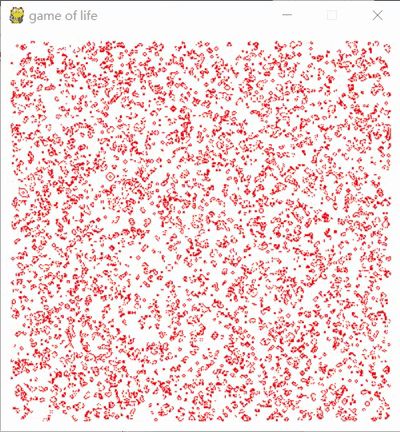模块:pygame
import pygame,sys,time,random
from pygame.locals import *
"""Color"""
WHITE = (255,255,255)
RED = (255,0,0)
GREEN = (0,255,0)
"""Color"""
def Neighbor(x,y):#返回周围存活细胞数
alive = 0
around = ((x+1,y+1),(x+1,y),(x+1,y-1),(x-1,y),(x-1,y+1),(x-1,y-1),(x,y-1),(x,y+1),)
for a in around:
color = WIN.get_at(a)
if color == RED:
alive += 1
return alive
def Init():
so = 200000
for number in range(0,so):
pygame.draw.rect(WIN,RED,(random.randint(0,SIZE[0]),random.randint(0,SIZE[1]),1,1))
print('so = ',so)
def rule(i,j):
if Neighbor(i,j) < 2:
return False
elif WIN.get_at((i,j)) == RED:
if Neighbor(i,j) == 2 :
return True
elif Neighbor(i,j) == 3:
return True
elif Neighbor(i,j) > 3:
return False
elif Neighbor(i,j) == 3:
return True
pygame.init()
SIZE = (800,800)
WIN = pygame.display.set_mode(SIZE)
pygame.display.set_caption("game of life")
WIN.fill(WHITE)
Init()
gen = 0
while True:
Next_alive = []
Next_dead = []
for event in pygame.event.get():
if event.type == QUIT:
pygame.quit()
sys.exit(0)
x = SIZE[0]
y = SIZE[1]
for i in range(10,x-10):
for j in range(10,y-10):
if rule(i,j):
Next_alive.append((i,j))
WIN.fill(WHITE)
print('Alive =',len(list(set(Next_alive))))
for x,y in list(set(Next_alive)):
pygame.draw.rect(WIN,RED,(x,y,1,1))
# for x,y in Next_dead:
# pygame.draw.rect(WIN,GREEN,(x,y,1,1))
gen += 1
print(gen)
pygame.display.update()
该代码的实现策略是遍历所有像素点,判断每个像素点下一代的状态,然后每个像素点状态写入数组,根据数组更新画面

这个方法有点暴力,像素过多的话会大量消耗资源,很慢












